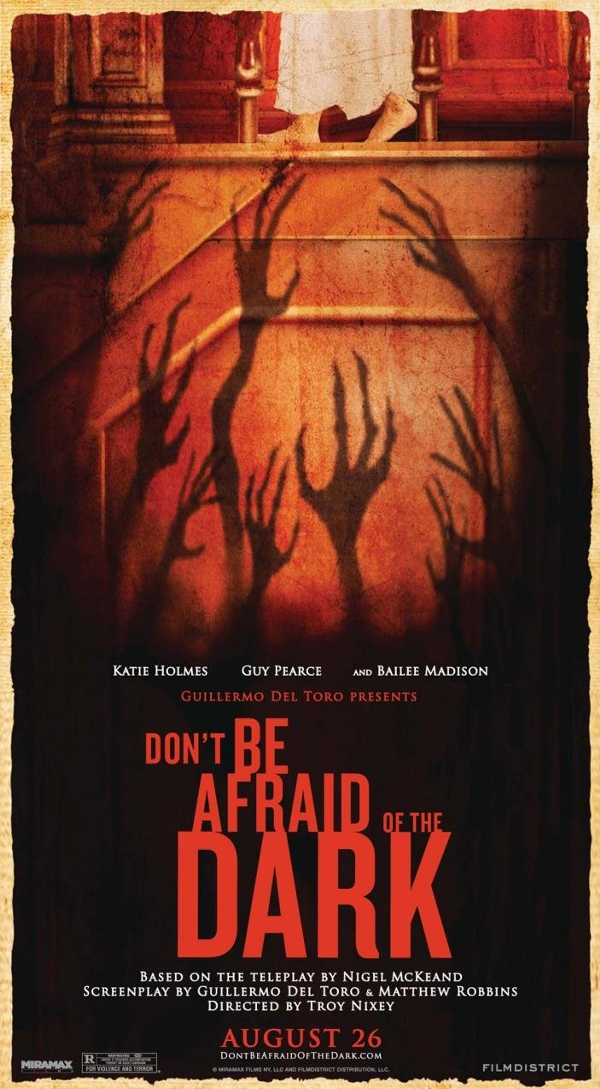TSR Blog: The Dying Art of the No-Show in ‘Don’t Be Afraid of the Dark’
Calhoun Kersten writes for The Scorecard Review, and he also has a blog called “Confessions of a Self Proclaimed Megalomaniac.” This TSR Blog is the first half of his article: The Dying Art of the No-Show in 'Don't Be Afraid of the Dark'  Horror is in a constant state of flux. Just from the time I was born back in 1987, I personally have seen the birth and death of the original slasher franchises (Halloween, Friday the 13th, and A Nightmare on Elm Street) and their subsequent resurrection in the late 2000s, the rise of the J-horror film (American remakes of Japanese imports), and the creation of the torture porn sub-genre. While it seems like none of these films have much in common, besides the blanket term of “horror,” these films are indicative of a new trend in the genre. While horror used to be recognized for its dimly-lit hallways and lurking shadows, modern horror has taken a sharp turn towards the aggressive and the obvious.
Horror is in a constant state of flux. Just from the time I was born back in 1987, I personally have seen the birth and death of the original slasher franchises (Halloween, Friday the 13th, and A Nightmare on Elm Street) and their subsequent resurrection in the late 2000s, the rise of the J-horror film (American remakes of Japanese imports), and the creation of the torture porn sub-genre. While it seems like none of these films have much in common, besides the blanket term of “horror,” these films are indicative of a new trend in the genre. While horror used to be recognized for its dimly-lit hallways and lurking shadows, modern horror has taken a sharp turn towards the aggressive and the obvious.
Audiences are no longer content with what they can’t see. They are no longer satisfied with Carpenter’s overly-simplified explanation of Michael Myers’ evil. Instead of the one line it was afforded in the seminal 1978 Halloween, it is the subject of great debate and roughly 45 minutes of exposition in Rob Zombie’s 2007 reboot. There is no more appreciation for the mystery of the horror genre. Quite literally everything is on display, from the villains themselves to the innards of their victims.
However, it must be understood that there has been a significant shift in the horror genre to overcompensate for these seemingly drastic changes. For instance, what would Saw be without the deliberate focus on the pain, suffering, and bodily harm of its protagonists? If the horror genre was relegated to only these cinematic blood baths, while that may pose a problem for the genre itself, horror would no longer, seemingly, be in conflict with itself.
As it exists now, horror has two extremes. On the one hand you have literal blood baths that seem to bask in the blood of their victims. On the other hand, you have the quieter, more subdued stories, which are frequently incorrectly referred to as psychological thrillers. While the two can certainly co-exist, horror films are being forced more and more often to try and reconcile the two extremes.
A prime example of this attempt, and inability to make peace between the two extremes is the 2011 remake of Don’t Be Afraid of the Dark. The movie follows a young girl, Sally (Bailee Madison), as she moves in with her father (Guy Pearce) and his girlfriend Kim (Katie Holmes). It isn’t long before Sally begins to hear strange voices and see strange things, which causes Kim to worry about the young girl’s safety and sanity.
CLICK HERE to continue reading The Dying Art of the No-Show in 'Don't Be Afraid of the Dark'